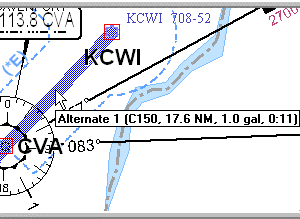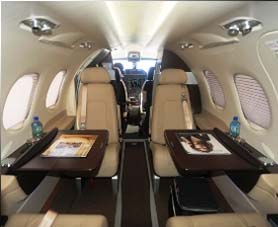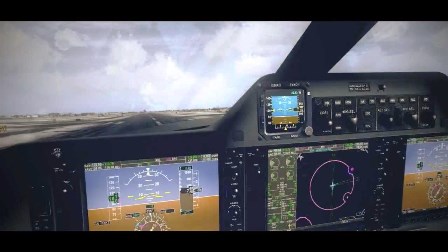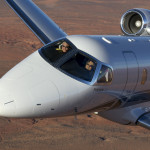 Alternate Destination Routing when there is a need to divert your Jet
Alternate Destination Routing when there is a need to divert your Jet
We’ve all been there. A trip is planned and at departure time the weather at the destination looks good enough; the ceiling is 800 feet, visibility 2 miles, the forecast at ETA is 1000 and 2. Lower weather than most of us see everyday but should be no problem as long as the forecast holds
But what if the forecast doesn’t turn out as planned? Once airborne and as we approach the airport what if the ceiling and visibility are lower than the observation we saw just prior to our departure? What airports other than the designated alternate will provide an “out”? Having a plan that keeps you “legal” is one thing–even better is a “backup” to the backup.
The Real World
During IFR training we’re all taught the rules and before we’re certified as instrument pilots we need to understand them–not just to be able to recite the rules but to apply them.
Part 91 operations specify that if the forecast ceiling at our planned destination is to be less than 2000′ and visibility less than 3 miles plus or minus an hour of our planned ETA then we need an alternate. For a prospective alternate to qualify there are several criteria we need to look at depending on the type of approaches available at the airport. But as operators, beyond just obeying the rules in our normal day-to-day flying, a typical trip can stretch the range capabilities of the airplane and will limit the available alternates to those close to our destination.
The problem with this approach is that the weather at the prospective alternate is probably similar to the destination weather thus defeating the purpose of the alternate, that is, a place we can go if our destination doesn’t work out whatever the reason. In the example above we’re legal but what about an alternate if the designated alternate doesn’t work out? A “hip pocket” option that isn’t necessarily written down and may not even be briefed but one that the pilot in command knows that if it “hits the fan” and I need somewhere to go in a pinch that that is where he’s headed.
Of course, there aren’t many options available to the pilot who takes his aircraft to its limits in range, whether legal or not. This “hip pocket” option probably won’t be available to the “no-margin”, take-it-to-the-limits pilot.
On the other hand, when our planned destination does not stretch the range limits of our airplane we will still normally pick an alternate that is close to our destination out of practicality–we’re using an airplane to go somewhere and we normally pick airports that are close to where we’re headed once we land.
What good is it to fly to an airport that is distant to where we want to go? This defeats the purpose of an airplane doesn’t it? So, with the above flight planning options in mind a hip-pocket or “plan C” option that gives you an option beyond the required alternate will always provide “out” as well as “peace” of mind.
Always Have an Out
On a recent trip with a Phenom 100 owner where I was flying in the right seat and acting as mentor for the owner-pilot, our planned trip was from South Carolina’s Charleston Executive airport (JZI) to Atlanta’s Fulton County airport (FTY). The weather at FTY was 800 OVC and 2 miles visibility.
The forecast for our arrival was 1000 feet and 2 miles. On the surface it seems like an easy trip, one that is well within the range capabilities of the airplane and one which we as a crew have made many times with similar weather conditions. Since the weather at FTY dictated an alternate we designated Cobb County McCollum Field (RYY) on our flight plan.
The weather at RYY was observed at our departure and forecast for our arrival at 1200 OVC and 3 miles visibility–comfortable weather for an alternate serviced with GPS WAAS approaches and nearby to our destination if we needed a change in plans. But what if we indeed needed to change our plans?
Was RYY of sufficient distance away from FTY to ensure that whatever weather conditions dictated a divert from our primary destination did not also spoil our alternate? Not in this instance but not because the ceiling and visibility wouldn’t allow us to land.
Takeoff from JZI was uneventful with the ceiling and visibility at takeoff 600 and 2 with some rain showers. We experienced solid IFR with moderate to heavy rain showers during the departure and didn’t see clear skies until Colliers VOR near Augusta, GA, about 20 minutes after takeoff. After breaking out of the weather at FL 240 enroute to our cruise altitude of FL 280 there was a sense of relief since we were able to relax a bit, look up from the Garmin G1000 PFDs and weather radar and see blue skies.
A Change in Plans
Enroute to Atlanta was uneventful and during the descent and arrival a look at the latest METAR for FTY gave us nothing to be concerned about. We were soon given vectors off the arrival and into some weather that looked tame on the weather radar. However, shortly after entering the clouds the Phenom began to be rocked by moderate turbulence with occasional brief bouts of severe.
We didn’t observe any cells but we did hear approach speaking to another aircraft that the winds at Hartsfield-Jackson were reported at 35 knots with gusts to 55! While Hartsfield was well south of our current position and our destination we were getting rocked by some heavy turbulence.
Additionally, we heard from the approach controller that a Citation enroute to FTY had just gone missed approach. Missed approach? What had happened? Five minutes earlier we had checked the observation at FTY and it was still 800 OVC and we hadn’t considered a change in plans. After I was able to get a word in edge-wise on a very busy morning, the controller clarified that the Citation had gone missed on the LNAV runway 8 approach at FTY. All things being equal, this meant that the real ceiling was more like 400 feet or possibly lower–we didn’t know. We still could fly the LPV approach to runway 8 with a DA of 250′ but based on the rapidly changing conditions and the reported and actual weather disparity we both had made the decision but just hadn’t communicated yet.
However, moments later, after getting rocked by a few more bouts of “lift-your-feet-off-the-rudder-pedal” turbulence we had had enough and decided it was time to try another airport a bit more friendly to our plans that wasn’t in the Atlanta vicinity and less likely to include the “roller coaster” turbulence we had experienced. After a brief discussion and checking the weather we decided we would give Anniston, Alabama (ANB) a try.
We had landed there before and since it is only a 45 minute drive to our ultimate destination it made our decision an easy one. I made our intentions known to Atlanta approach who efficiently provided our clearance to climb and proceed through the busy Atlanta Class B airspace and over to Anniston. Twenty minutes later we were on the ground
Lessons Learned
After landing my thoughts turned to what we could have done differently. Based on our plan and the weather conditions we observed both prior to takeoff and during the flight I don’t think there was anything flawed in the planning. There were no reports or forecasts for the turbulence we experienced nor was the forecast weather for our destination expected to get worse.
Alternate Destination Routing Diverting your Jet
However, the experience has renewed my belief that the old adage learned by every pilot early in their flying careers is a good one: to always give yourself an out. From a legal and practical perspective the FARs are a starting point where an alternate is concerned. Even better is a backup or “alternate for the alternate“–a place to go when even our backup plan is not an option.
if you are looking for a safe, qualified and friendly pilot for your flights contact us;
Dave @ (904) 631-0153






